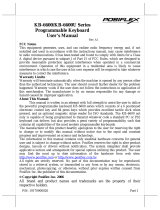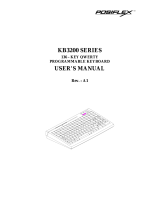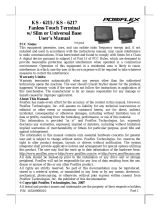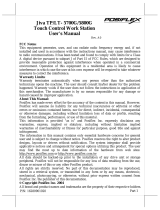Page is loading ...

Part 1
FCC Notes:
This equipment generates, uses, and can radiate radio frequency energy and, if not
installed and used in accordance with the instructions manual, may cause interference
to radio communications. It has been tested and found to comply with limits for a Class
A digital device pursuant to subpart J of Part 15 of FCC Rules, which are designed to
provide reasonable protection against interference when operated in a commercial
environment. Operation of this equipment in a residential area is likely to cause
interference in which case the user at his own expense will be required to take whatever
measures to correct the interference.
Warranty Limits:
Warranty terminates automatically when any person other than the authorized
technicians opens the machine. The user should consult his/her dealer for the problem
happened. Warranty voids if the user does not follow the instructions in application of
this merchandise. The manufacturer is by no means responsible for any damage or
hazard caused by improper application.
About This Manual:
Posiflex has made every effort for the accuracy of the content in this manual. However,
Posiflex will assume no liability for any technical inaccuracies or editorial or other
errors or omissions contained herein, nor for direct, indirect, incidental, consequential
or otherwise damages, including without limitation loss of data or profits, resulting
from the furnishing, performance, or use of this material.
This information is provided “as is” and Posiflex Inc. expressly disclaims any
warranties, expressed, implied or statutory, including without limitation implied
warranties of merchantability or fitness for particular purpose, good title and against
infringement.
The information in this manual contains only essential hardware concerns for general
user and is subject to change without notice. Posiflex reserves the right to alter product
designs, layouts or drivers without notification. The system integrator shall provide
applicative notices and arrangement for special options utilizing this product. The user
may find the most up to date information of the hardware from web sites:
http://www.posiflex.com or http://www.posiflex.com.tw or http://www.posiflexusa.com
All data should be backed-up prior to the installation of any drive unit or storage
peripheral. Posiflex will not be responsible for any loss of data resulting from the use,
disuse or misuse of this or any other Posiflex product.
All rights are strictly reserved. No part of this documentation may be reproduced,
stored in a retrieval system, or transmitted in any form or by any means, electronic,
mechanical, photocopying, or otherwise, without prior express written consent from
Posiflex Inc. the publisher of this documentation.
© Copyright Posiflex Inc. 2006
All brand and product names and trademarks are the property of their respective holders.
K
P
-
2
00
/ KP
-
210
SIDE MOUNT
PROGRAMMABLE KEYPAD
USER’S MANUAL
Rev.: Original
P/N: 19810900010

Part 2
GENERAL DESCRIPTION
OVERVIEW
Table below indicates construction of this series of security devices.
KP-200 KP-210
Structure
Upgrade kit for HT
series
Upgrade kit for
TM/LM-7112 series
Programmable keypad
Vertical layout
Magnetic stripe reader
Optional
Smart card reader Optional
OPTIONS
Items underlined below means that this item must be installed by Posiflex
authorized distributor only and never by average user. Items in Italic printing
below means that this item must be installed prior to delivery from the factory.
• Magnetic Stripe Reader (PS2 KB interface)
∗ ISO 7811 head reader for tracks 1 and 2
∗ ISO 7811 reader head for tracks 2 and 3
∗ ISO 7811 reader head for tracks 1, 2 and 3 + AAMVA + CA DMV
∗ JIS/II reader head
• Smart card reader
• Case color selection between ivory and charcoal
Note: if there is no smart card reader option installed with the keypad, there
will be no USB interface and cable installed.

Part 3
INSTALLATION GUIDE
UNPACKING CONTENTS
Items packed in for Qt’y
The side mount programmable keypad itself 1
Fixation screws with washers to hold KP to HT or TM/LM 2
Transparent key caps for single key 20
Key clip 1
Control keys (4 pcs / set) 1
Legend sheets (4 sh. / set) 1
This manual 1
Note: Utility drivers for KP-200 / KP-210 can be found in the CD ROM
packed together with the Posiflex HT series POS terminal system or
monitor TM-7112 or LM-7112 that this upgrade kit is to be installed to.
Or please find for latest updates by visiting driver download page of our
web site: http://www.posiflex.com.tw/DriversDownload.asp
MECHANICAL FIXATION
Either the KP-200 to be installed in the HT series host system or the
KP-210 to be installed to the stand-alone touch/LCD monitor TM/LM-7112,
the upgrade kit is installed to the right edge of the
LCD panel. Use the 2 fixation screws that come
along with KP-200 or KP-210 to hold the keypad
unit to the LCD panel from its back as circled in the
left picture. Connect the PS/2 cable of KP-200 to
the PS/2 KB port in connection area inside the back cover of HT system.
Connect the much longer PS/2 cable of KP-210 to the PS/2 KB port of the host
system that the TM/LM-7112 is connected to.
For the smart card reader option in the keypad, there will be an USB
cable coming from bottom of the keypad. Please hold
it to the holder on back of the LCD panel as arrowed
in the above picture and connect it
to the extended USB port of HT
system or to a downlink USB port
in TM/LM-7112 monitor. Find the
downlink USB port of TM/LM-
7112 is at right side of its base unit
as in the left picture. Find the top
side cable cover of HT series as in the upper right
picture and gently press it down and slide aside to open it and connect the USB
Cable Exit
Cable Cover
Downlink
USB Ports
Extended USB Port

Part 4
cable of KP-200 to the extension USB port as shown in the lower right picture
in last page.
EXTENDED PS/2 KEYBPARD CONNECTION
Refer to the right picture on back
of KP-200 / KP-210 with a partially
enlarged picture at inclined angle. In the
cavity found at lower rear side of KP-200 /
KP-210, there is a PS/2 KB jack. Connect
a standard PS/2 keyboard device to this
jack and insert the cable from the PS/2
keyboard device into the cable pass for
strain relief and fixation when an extended
PS/2 KB is required.
KEYTOP LAYOUT
Keytop Replacement
The keypad in KP-200 / KP-210 is organized into 2 parts: a 4 by 4
numerical keypad area and a 4 by 6 matrix minus a 2 by 2 square recess
programmable keypad area. However, this keypad allows some layout
alterations by the system integrator. Besides the standard single key installed,
there are double keys and blank keys for purchase to provide more convenient
interface with the user.
When replacement of keytop is required, it is advisable to use a
flattop (minus sign) screw driver (Do not use the attached key clip for this
operation.) to help getting the key top off gently. Please always first orientate
the key tops as below before inserting any keytop into the case of the keypad.
Failure to do so could result in permanent damage not covered in product
warranty. Please always match the latching tab on bottom stem of keytop with
the tab in guiding hole and gently press the key top down till a click sound is
heard as indicated in the pictures below.
Single key top
Latching tab
Double key top
Tab in the
guide hole
KP-200 / KP-210
Rear View
Cable
Pass
KB Jack

Part 5
Labeling On Keytop
The programmable keypad is provided with an easy and durable
method for reminding the user of content programmed in each programmable
key. First preprint (or write) in each cell of the attached colored legend sheet
the “name” for each key. Stick each cell to the corresponding keytop and then
put on the transparent key cap from the accessories. In this way, the labeling
will be protected and resistant to scratch or rubbing.
When re-labeling is required, please use the attached key clip to hook
up the transparent key cap and change the label then re-cap.
KEYPAD PROGRAMMING
The programming of the keys above the numerical keypad in KP-200
or KP-210 is in general the task of the system integrator and not the average
end user. For end user, please go to the chapter of “OPERATION GUIDE” of
this manual directly.
Utility Installation
In the Posiflex Product Information CD attached with Posiflex POS
terminal, there is a subfolder named as “\Drivers\KP”. If there is only a
subfolder like “\Drivers\KP100” but not “\Drivers\KP”, please download from
our web site: http://www.posiflex.com.tw/DriversDownload.asp the keypad
programming utility for KP-200 / KP-210.
In the above mentioned subfolder there are 2 further subfolders
“KBM40.xxx” and “KBW40.xxx” with “xxx” representing any number of the
utility revision. For operating system of MS-DOS or Win98 DOS box, please
execute “KBM40.xxx\INSTALL.EXE” to install the utilities “KBM.EXE” and
“RWM.EXE”. The “KBM.EXE” is a key-by-key programming utility for DOS
environment. The “RWM.EXE” is a special direct transfer utility under DOS.
Execute “KBW40.xxx\SETUP.EXE” to install the programming utility
“KBW.EXE” for various editions of Windows OS. After completion of the
“Setup”, there will be a program group “Posiflex Tools” in the program files.
Clicking the program “Posiflex Programmable Keyboard” in this group will
activate the KBW.EXE for KP-200 / KP-210. Please select the right model
when entering the program.
Programming Preparation
A normal keyboard may be required for inputting data in keypad
programming. If a PS/2 interface keyboard is to be used, please connect it to
the extended PS/2 KB jack in the recessed cavity on back of KP-200 / KP-210
as mentioned earlier. Please note that there must not be any other PS/2 device
connected in between the KP-210 and the PS/2 KB port of the host system in
the keypad programming operation.

Part 6
Quick Reference Guide for Keypad Programming
Please refer to our web site for every detail in programming the
programmable keyboards or keypads. The following simplified guide severs as
a concise tool for instant application.
Keys To Program How to Program Them
Esc, F1 - F12, Back Space, Shift,
Ctrl, Alt, Insert, Delete, End, Page
Up, Page Down, Print Scrn, Scroll
Lock, Break, and all Arrow
Functions
Press: (Alt-N), Esc, “Desired Key”,
Down Arrow
A - Z, 0 - 9, ~ ` ! @ # $ % ^ & * ( )
- _ = + } { [ ] | \ ’ ; ” : /. , < > ?
Press: Enter, “Desired Key or
Keys”, Down Arrow
Tab, Enter
Press: (Alt-N), “Desired Key”,
Down Arrow
Caps Lock Press: Enter, (Alt-C), Down Arrow
Multi-shift
Press: (Alt-N), (Alt-M), Down
Arrow - - - - Press (Alt-M) as many
times as needed.
Separator In Between Any Text, Press (Alt-S)
Hardware Limitation in Programming
In case of “multiple combination key” application which means
pressing three or more keys at the same time to obtain certain data output from
the keyboard, there could be some limitations inherent from the nature of
keyboard structure. The CPU of keyboard detects the contact between the
“horizontal” and “vertical” lines for each key press, recognizes which key is
pressed and sends correspondent data to the host computer. When there are
many keys pressed at the same time, and the pattern of the contacts coincides
with some special relationship, there are chances that the CPU of keyboard be
confused about exactly which keys are pressed. The user may change the
locations of the key-definition to prevent this once such confusion happens.
MSR CONFIGURATION
Please find the subfolder “\Drivers\KP\MSR” in the Posiflex Product
Information CD or download from our web as mentioned earlier and go to
either the subfolder “DOS” for the MSR manager under MS-DOS or the other
subfolder “Win” for setting up the MSR manager under Windows OS. The
MSR manager can control parameters like individual track enable/disable,
Alt+Num emulation and Start/end sentinel substitute.

Part 7
SMART CARD READER DRIVER INSTALLATION
This driver should be installed in the system prior to the system
detection of the new hardware. Therefore, the USB connection of KP-200 /
KP-210 could have to be disconnected before driver installation and then
connect it back afterwards. Please find the subfolder “\Drivers\KP\SC200” in
the Posiflex Product Information CD or download from our web as mentioned
earlier. Execute the “SETUP.EXE” to install the driver into the Windows OS.
The reader is PC/SC 1.0 compliant. The reader is also EMV level 1 compliant.
The smart card reader is also supported by Microsoft CCID generic class
driver.

Part 8
OPERATION GUIDE
KEYPAD LAYOUT
1. 6 position lock switch for electronic control key
2. Multi-page programmable keys (Note: The white keys in dark
color keypad in the example picture is for illustration purpose
only. In normal product, they will be of same tone.)
3. Numerical keypad
4. MSR slot
5. MSR mark
6. Smart card reader slot
7. Smart card reader mark
8. Example smart card to be read
PROGRAMMABLE KEYPAD
Electronic Control Key
On top right corner of KP-200 / KP-210, there is an electronic control
key that can be turned to one of the following 6 positions: LP, L0, L1, L2, L3
and L4. It can only be taken out from the switch at positions L0 and L1. The
purpose of this electronic key serves 3 folds: When the key is switched to (and
extracted from) position L0, the whole keypad output (including the optional
MSR but excluding the optional smart card reader) will be blocked off by
hardware to work as a security measure. A programmable answer back code
for the final position of the 6 position electronic key will be sent by the keypad
to the host computer whenever the key is switched to a new position for a
programmable delay time or when the host computer sends a specific code
(E7h) to inquire the keypad. The position of the electronic key determines
which page of the key content table for the 20 push keys applies, while the
definitions of the same key within different pages can be programmed so
absolutely independent to provide instant menu change over.
1
2
3
4
5
6
7
8
Front View
Front Right Side View

Part 9
This electronic key switch is delivered with a set of 4 pcs of keys,
each marked as “PRG”, “REG”, “Z” and “GT”. The effective range of each of
the 4 keys can be illustrated by the following table and drawing.
PRG REG Z GT
LP Y N N N
L0 Y Y Y Y
L1 Y Y Y Y
L2 Y Y Y Y
L3 Y N Y Y
L4 N N N Y
Programmable Keys
The multi-page programmable keys can deliver to the host system the
string of keyboard input as programmed. Please note that when the 6 position
electronic control key is turned to a different position, the content of same key
could be completely different. It is also possible to use combination keys if
programmed to. There will be no output of these keys if the control key is
turned to “L0” position.
Numerical Keypad
The numerical keypad is durably pre-marked. When the 6 position
electronic control key is turned to a different position, the content of same key
remains unless it has been programmed in a particular way. The numerical
keypad is not applicable in combination keys. There will be no output of these
keys if the control key is turned to “L0” position.
MAGNETIC STRIPE READER
For magnetic stripe card reading, be sure to insert the card to the
bottom with magnetic stripe facing the mark aside the slot. The movement of
the card can be either inserting the card from the top surface then sliding the
card down out of the slot, or sliding the card upward from the lower side of the
slot till it reaches the top end as long as the card is a standard one. A non-
standard card recorded without complete degaussing prior to recovery may
accept only one direction in card reading.
The magnetic stripe reader in KP-200 / KP-210 connects to the host
through KB port and therefore requires no driver installation to get it working.
However, when the control key is turned to “L0” position, the output of any
MSR reading is blocked for security concern.

Part 10
SMART CARD READER
Card Insertion
For smart card reading, please insert the end of the smart chip first
and have the chip facing the mark aside the side slot of KP-200 / KP-210 as in
the example picture in front side view.
Applicable Smart Card Type
The smart card reader can be used for both asynchronous and
synchronous type smart cards. For asynchronous type smart card, it reads the
card with T = 0 and T = 1 protocols up to 340 Kbps of EMV and ISO modes.
For synchronous type smart card, coverage includes: 2-wire (SLE4432/42), 3-
wire (SLE4418/28) etc., SDA/I2C, 4403, 4433, 4404, 896
T31454
/




